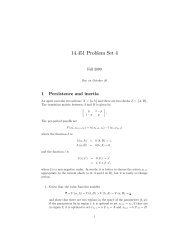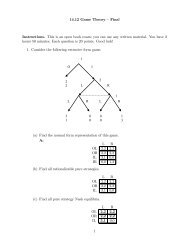22.058 Principles of Medical Imaging Fall 2002 Homework #3
22.058, Principles of Medical Imaging Fall 2002 Homework #3
22.058, Principles of Medical Imaging Fall 2002 Homework #3
- No tags were found...
Create successful ePaper yourself
Turn your PDF publications into a flip-book with our unique Google optimized e-Paper software.
<strong>22.058</strong>, <strong>Principles</strong> <strong>of</strong> <strong>Medical</strong> <strong>Imaging</strong><br />
<strong>Fall</strong> <strong>2002</strong><br />
<strong>Homework</strong> <strong>#3</strong><br />
________________________________________________________________________<br />
1. Define aliasing, bandwidth limiting and the Nyquist condition.<br />
2. Using your knowledge <strong>of</strong> Fourier convolution, calculate the Fourier transforms <strong>of</strong> the<br />
following functions and draw both the real and imaginary spectra. k 0 is a real<br />
number.<br />
a. cos 2 (k 0 z)<br />
b. sin 3 (k 0 z)<br />
3. The spot size <strong>of</strong> an X-ray source typically looks like 2 rectangles. Below is a schematic<br />
representation <strong>of</strong> a X-ray source. We expect that the image resolution will depend<br />
on this source distribution. Recall that we typically assume that the source is a<br />
infinitesimal point source radiating in all directions, here the source is a distributed<br />
source with each infinitesimal element radiating in all directions.<br />
0.5 mm<br />
2 mm<br />
2 mm<br />
a. Describe how you would use a pin-hole camera to measure the spot size. In your<br />
analysis forget about the <strong>of</strong>f axis effects (no oblique angle correction).<br />
b. Given a detector with 1 mm x 1 mm spatial resolution and that you desire to<br />
characterize the spot size to a resolution <strong>of</strong> 100 µm, how will you set up the<br />
measurement (distances from source to pin-hole to detector, size <strong>of</strong> pin-hole).<br />
c. What is the 2-dimensional Fourier Transform <strong>of</strong> the 2-dimensional function describing<br />
the above X-ray source distribution? Draw this and label the axes.<br />
d. The Fourier Transform <strong>of</strong> the X-ray source has pronounced oscillations. To remove<br />
these oscillations one can file down the edges which replaces a sharp edge by a<br />
triangular edge:
Show that in k-space the trapezoid function falls <strong>of</strong>f faster than the TopHat function with<br />
increasing k (wave-number). You do not have to calculate the actual Fourier<br />
Transform to answer this.
















